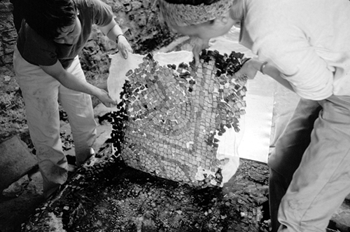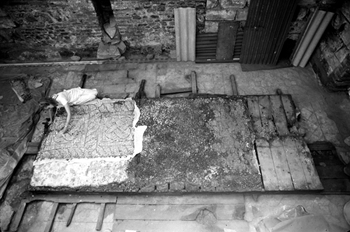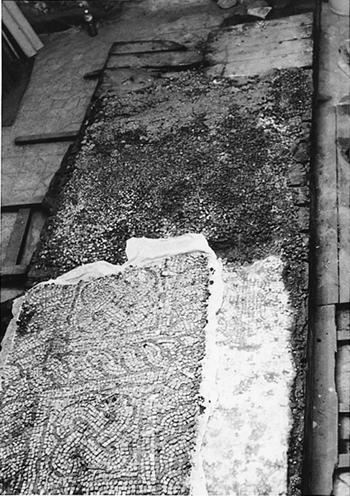RECOVERY OF UNBACKED MOSAICS FROM A STORAGE DEPOT FIRE AT THE SARDIS EXCAVATIONS, TURKEYKENT SEVERSON, STEPHEN KOOB, JULIE WOLFE, PERRY CHOE, STEPHANIE HORNBECK, SARAH MCGREGOR HOWARTH, & ANTHONY SIGEL
4 4. FURTHER TRIALS IN RECOVERYAt the beginning of the 1998 season, further examination of the mosaic stacks was carried out by conservators, and, based on this examination, it was agreed that the top layers were irreversibly damaged and could not be salvaged. Lifting random tesserae from the top of the stack revealed that the stones were charred on the front and backside. Tests using organic solvents, dilute mineral acids, and even abrasive cleaning were not successful in regaining the original white and blue coloration in the stones (Wolfe 1998). The top layers of the mosaic were sacrificed during the first stage of recovery and used to test methods for recovering undamaged sections. The jumbled tesserae around the perimeter were also removed to expose the cross section of the stacks and so determine the overall condition. These simple actions transformed the stacks from piles of rubble to stacks of four or five layers of mosaics separated with partially melted polyethylene sheet, deteriorated kraft paper, and the original cotton facings. Lifting the upper layers proved that, indeed, some of the tesserae remained in order and were not charred by the fire. The separating layer of plastic appeared to have melted slightly and fused to the backside of the tesserae but could be mechanically removed by tearing. The animal glue used to face the mosaics had remelted, flowed, and redeposited, making the sandwich of mosaic sections a complex intermixture of facing materials and stones that varied in condition from layer to layer. Using tesserae that had fallen or were removed from the stack, conservators tested methods for lining a layer for lifting and separating the mosaic sections. Pressure-sensitive tapes, such as duct tape, 3M Scotch 471, and 3M Scotch 850 polyester tape, were tried without success. Lining techniques were tested using cheesecloth and various adhesives that included Paraloid B-72 in acetone and Primal AC-33. Both resins successfully adhered the tesserae to the cheesecloth, but the Primal acrylic emulsion was selected for use because it did not require the use of expensive and toxic solvents and it provided longer working time. The adhesive was also readily available for purchase in Turkey. The top surfaces of the tesserae to be lined were first cleaned using low vacuum pressure and a soft brush to remove surface dirt and particulate matter. Cheesecloth moistened in a 10% solution of Primal AC-33 and water was draped over an area 1 m sq. and pounded into the crevices using a dry brush. After pounding, a 40% solution of the adhesive was brushed onto the cheesecloth. When the lining was dry, the layer was carefully lifted by wedging both hands underneath the lined tesserae and manually detaching any stones that were still clinging to the old facing cloth (fig. 11).
Using this lining technique, the top layer was removed from the badly damaged south end of the longest stack of mosaics where the fire had penetrated beneath the platform. The second layer was in better condition, with less disorder and charring. As the lining procedure continued and the stack was methodically peeled apart, the condition of the mosaics improved. It was surprising to find in the middle of the stack some of the original kraft paper intact and the original permanent marker labeling still legible. A second test method for recovering the charred mosaics involved removing an entire section from a stack by sandwiching the layers between boards and then flipping the entire package. The first trial was also attempted on the badly damaged south end of the largest stack. A thin sheet of steel was slid between the bottom of the mosaic stack and the supporting plywood palette, and the section was separated from the stack using a utility knife to cut the surviving cotton, paper, and plastic. The truncated section was then transferred to a wooden plywood board and framed with polypropylene foam adhered to the plywood. The top of the mosaic was protected with polyethylene sheet and an expanding polyurethane foam (of the type used for building construction) laid in the space between the mosaic and the frame. A piece of plywood was placed on top, forcing the foam to fill the voids and crevices on the surface of the mosaic section, locking it in place. After the mosaic section was secured between the plywood boards and foam using C-clamps, it was flipped and disassembled. Lifting the plywood cover, the face of the tesserae from the mosaic section originally stored on the bottom of the wood palette was exposed as a flat layer, ready for immediate facing (fig. 12).
In the course of the 1998 season, approximately 2.5 � 3 m of mosaic were declared unsalvageable and removed (fig. 13). A total of 7 m sq. was recovered and stored in racks in the depot. Excluding unsalvageable material still in place, it is estimated that 10 more sections of recoverable mosaics remain in the stacks. A combination of these two techniques for recovering the mosaic sections will continue to be used during the 1999 season (Wolfe 1998).
|


